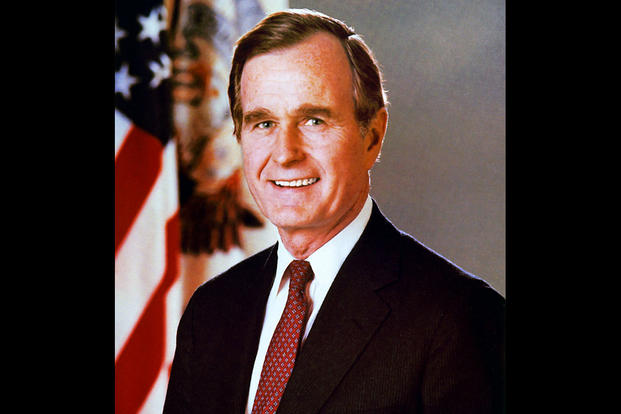Former President George H.W. Bush is remembered for many achievements and events, including the 1991 Gulf War, his distaste for broccoli and that snafu with the prime minister of Japan. What you may not know is that he narrowly avoided being eaten by cannibals during World War II.
Born into the wealthy Bush family of New England and raised into a charmed life, young George and the Bushes weren't affected by the Great Depression that plagued the United States and much of the world in the 1930s. He attended the elite, private Phillips Academy in Andover, Massachusetts, instead of a public high school, graduating in 1942.
But immediately after graduating and turning 18, Bush didn't shirk the call of duty. His country was now at war, and he immediately joined the U.S. Navy and became a naval aviator. After a year of training, he was sent to the Pacific Theater in 1944. Bush was stationed aboard the USS San Jacinto, flying Grumman TBF Avenger torpedo bombers.
Bush's first combat assignment came in May 1944, bombing targets on Japanese-held Wake Island. For that successful attack, he was promoted to lieutenant, but perhaps his most memorable mission (to him anyway) came during a bombing over Chichijima that same year. Bush and his wingmen successfully hit their targets, but they were downed by enemy anti-aircraft fire.
Ten naval aviators were forced to evade capture on the Japanese island. Nine of them were captured, and only Bush managed to get to safety. All nine of the captured pilots died in the hands of their captors; four of them were eaten. The only way Bush avoided the same fate was by bailing out over water. He was rescued by the U.S. Navy submarine USS Finback.
But Bush didn't learn the fate of his compatriots until 2003, when author James Bradley researched what happened that gruesome day. Bush stayed aboard the Finback for weeks, helping the crew rescue other downed American aviators. He returned to the San Jacinto where he began training for the invasion of mainland Japan, which, thankfully, never came. He returned to the Navy Reserve until 1945 and was formally discharged in 1955.
Related: Get complete military-to-civilian transition support at the Transition Center.
Upon returning home, he was a married man, having married Barbara Pierce while on leave in January 1945. He attended Yale University and began working his way up through the oil industry in Texas. He founded a couple of oil companies, which he later sold.
In 1964, Bush entered politics by attempting to unseat a Democrat from his U.S. Senate seat, but the bid failed. Two years later, he ran for the House of Representatives in the 7th District of Texas, an election he won. He gave up his seat in the House in 1970 to run for the same Senate seat he lost in 1964 but was defeated once more.
His career in politics continued after that, when President Richard Nixon appointed him as U.S. ambassador to the United Nations in 1971, then as chair of the Republican National Committee in 1973. President Gerald Ford appointed Bush to chief of the U.S. Liaison Office in the People's Republic of China in 1974 and to CIA director in 1976.
When Jimmy Carter took office in 1977, Bush went back to Texas where he resumed a private life, working on the board of directors at a bank and teaching as a professor at Rice University. He still maintained a seat on the Council on Foreign Relations and the Trilateral Commission. In 1980, he entered the presidential primary as a Republican, where he won in Iowa and Massachusetts, but ultimately dropped out in favor of Ronald Reagan.
Reagan ultimately chose Bush as his running mate, and the duo beat the incumbent Carter-Walter Mondale ticket in an Electoral College landslide. Bush served for eight years as Reagan's vice president before running for president once more in 1988. His victory that year made him the first sitting VP elected to the Oval Office since Martin Van Buren in 1836.
President George H.W. Bush navigated the United States through the end of the Cold War, the invasion of Panama and the 1991 Gulf War. He enacted legislative protections against discrimination for disabled Americans, amended the Clean Air Act to improve its environmental protections and attempted to force Congress to "pay as you go" when it came to new spending.
Though his first term largely went well for the country, critics maintained that the Bush administration had no cohesive vision for the future. When the United States economy went into recession in 1990 and 1991, Bush largely took the blame. The state of the economy (and some say the candidacy of H. Ross Perot) led to his defeat against Bill Clinton in 1992.
After returning to private life, Bush made sporadic public appearances to support Republican candidates, including son George W. Bush's bid for the White House in 2000. He also used his prominence to support fundraising efforts to help recovery from natural disasters like Hurricane Katrina, the 2004 Indian Ocean tsunami and the 2010 Haiti earthquake -- often appearing with then-former President Clinton, who had become a close friend.
Bush received the Presidential Medal of Freedom from President Barack Obama in 2011 for his lifetime of service to the United States. Bush died in November 2018 from vascular Parkinsonism at age 94.
His casket lay in state in the Capitol Rotunda for three days before he was interred at the George H.W. Bush Presidential Library in College Station, Texas, next to his wife.
-- Blake Stilwell can be reached at blake.stilwell@military.com. He can also be found on Twitter @blakestilwell or on Facebook.
Want to Know More About Veteran Jobs?
Be sure to get the latest news about post-military careers as well as critical info about veteran jobs and all the benefits of service. Subscribe to Military.com and receive customized updates delivered straight to your inbox.
Related: Famous Veteran: Bob Ross












